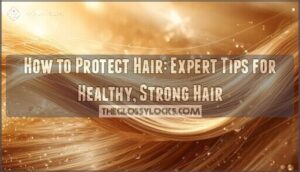This site is supported by our readers. We may earn a commission, at no cost to you, if you purchase through links.

The techniques that work don’t require expensive treatments. They require consistency with a few evidence-based methods that support your hair’s natural cycle.
Table Of Contents
- Key Takeaways
- Hair Growth Techniques
- Fast Hair Growth Tips
- Hair Growth Promotion
- Healthy Hair Growth Habits
- Maximizing Hair Growth Potential
- Frequently Asked Questions (FAQs)
- Which is the best method for hair growth?
- What is the best procedure for hair growth?
- Can I grow 6 inches of hair in 6 months?
- How do I grow my hair fast naturally?
- Can stress and anxiety cause hair loss?
- How does age affect hair growth speed?
- Do hair growth shampoos actually work effectively?
- Can certain medications slow down hair growth?
- Why does hair grow faster in summer?
- How does hormonal balance affect hair growth rate?
- Conclusion
Key Takeaways
- Your hair grows fastest when blood reaches your follicles through daily scalp massage, which studies show can increase strand thickness by about 8% after six months of consistent four-minute sessions.
- What you eat matters more than what you apply—protein builds the keratin structure of each strand while iron, zinc, and B vitamins keep your growth cycle running, so deficiencies push hair into a resting phase that causes thinning.
- Breaking less matters as much as growing more, since regular coconut oil use reduces strand irregularities by 65% and avoiding heat above 150°C prevents cuticle damage that can cut tensile strength by 30%.
- Natural methods like rosemary oil work as effectively as prescription minoxidil after six weeks of use, while sleep supports growth by triggering hormones that repair follicles and lower cortisol levels that cause premature shedding.
Hair Growth Techniques
Growing healthier hair starts with understanding what actually works. The methods below combine nutrition, scalp care, and daily routines that support your hair from root to tip.
Let’s look at the approaches that can make a real difference.
Natural Hair Growth Methods
From rosemary oil to scalp massage, natural methods support your hair’s growth cycle gently. A 2022 study showed rosemary oil worked as well as minoxidil after six weeks. Try massaging your scalp daily—this boosts blood flow to follicles. Essential oils like peppermint and lavender improve circulation too.
Plant-based essences and botanical extracts nourish roots without harsh chemicals. Adding biotin-rich foods strengthens strands from within. Some studies suggest saw palmetto benefits hair density. These herbal remedies create healthy conditions for growth naturally.
Dietary Changes for Hair Growth
Your body needs the right fuel to grow strong hair. Hair is mostly keratin—a protein that demands a steady supply from your diet. Protein intake directly affects how quickly your strands grow. When you don’t get enough, your hair shifts into a resting phase and starts thinning.
Vitamin deficiencies slow growth too. Iron fuels follicles, while zinc and B vitamins keep your growth cycle humming. Hydration levels matter more than you’d think—water carries nutrients straight to your scalp. Omega-3 sources like salmon and walnuts strengthen roots and reduce inflammation. Eggs, spinach, and almonds pack antioxidant support that shields follicles from damage. Including foods rich in protein is essential for healthy hair.
Think of it this way: healthy hair growth starts on your plate. Protein-rich foods build the foundation while vitamins fine-tune the process.
Hair Care Routine for Growth
Gentle Cleansing with sulfate-free shampoo promotes scalp health without stripping natural oils. Research shows frequent washing—five to six times weekly—improves Hydration Balance and reduces oxidative stress on your scalp. Pair this with conditioner after each wash to cut breakage by 20–25%.
Product Selection matters. Choose growth-focused serums and seal moisture with lightweight oils. Your Night Routine should include leave-in treatments that work while you rest. Routine Personalization based on your hair type and seasonal needs turns basic hair care routine for growth into healthy hair growth methods that deliver results.
Fast Hair Growth Tips
Want your hair to grow faster? The right approach can shorten your wait without sacrificing health.
Scalp Stimulation through daily massage boosts blood flow to follicles—studies show 70% of participants gained thicker hair after six months of four-minute sessions. Rapid Hydration matters inside and out. Drink plenty of water and apply lightweight oils twice weekly for a Nutrient Boost. Product Selection counts: look for natural hair growth methods like rosemary oil, which matched 2% minoxidil results in trials.
- Switch to silk pillowcases to reduce friction breakage overnight
- Skip heat tools that weaken strands and slow Accelerated Growth
- Use wide-tooth combs starting at ends to prevent snapping
- Try rosemary water rinses for circulation without harsh chemicals
These fast hair growth tips protect what you’ve grown while encouraging new length. Consistency beats expensive solutions every time.
Hair Growth Promotion
Growing your hair isn’t just about waiting—it’s about taking the right steps to support what’s already happening beneath the surface. You can boost your results by focusing on three key areas that work together to create the best environment for growth.
Let’s look at practical ways to promote healthier and faster hair growth.
Scalp Massage for Hair Growth
Your scalp is home to millions of hair follicles that need steady blood flow to thrive. When you massage your scalp for just five minutes daily, you’re not simply relaxing. You’re triggering real biological changes. Research shows that mechanical pressure from massage techniques activates dermal papilla cells deep in your scalp. These cells respond by signaling hair follicles to grow.
Studies found that participants who practiced regular scalp massage saw hair thickness increase from 0.085 mm to 0.092 mm after 24 weeks. The boost in blood circulation delivers oxygen and nutrients directly to your roots. This process also aids stress reduction by lowering cortisol levels. Lower stress means healthier hair cycles.
Plus, massage improves product absorption when you apply oils or serums. Use your fingertips in gentle circular motions across your entire scalp to optimize these benefits for hair growth and scalp health.
Reducing Hair Breakage
Broken strands snap your progress before you even notice. Research shows that regular coconut oil use reduces hair diameter irregularities by 65%, strengthening each strand against breakage.
Heat styling above 150°C lifts the cuticle and shrinks fibers, while chemical treatments can slash tensile strength by 30%. UV damage strips up to 35% of protein content, so shield your hair outdoors.
Protect your hair with heat protectant, wide-tooth combs on damp strands, and pH-balanced conditioners that cut friction by 30%. Trim split ends every 8–10 weeks to stop cracks from traveling upward.
Hair Growth Supplements
Supplements offer a shortcut when your diet falls short. The global hair growth supplements market reached USD 810 million in 2024 and is projected to hit USD 2.9 billion by 2033, driven by rising consumer demand for natural solutions.
Look for biotin, zinc, iron, and saw palmetto—clinical trials show these essential nutrients for hair growth can reduce hair loss by 29% and boost density by 7.6% within 16 weeks. Ingredient safety matters: FDA warnings about unapproved topical finasteride highlight the importance of regulatory oversight.
Hair growth vitamins work best with consistent use over 4–6 months, so patience pays off.
Healthy Hair Growth Habits
Growing healthy hair isn’t just about what you apply—it’s about building habits that protect what you already have. The choices you make every day can either support your hair’s natural growth cycle or work against it.
Let’s look at three key practices that help you maintain strong and resilient hair.
Protecting Hair From Damage
Heat styling can weaken your hair faster than most people realize. Studies show that temperatures above 180°C destroy proteins and reduce hair strength considerably. Always apply a heat protectant before using hot tools—it can cut moisture loss by half. Limit heat styling to twice weekly and air-dry when possible.
Switch to a silk pillowcase to minimize friction overnight, reducing hair breakage by up to 35%. Trim split ends every eight weeks to stop damage from traveling up the hair shaft. Low-manipulation hairstyles and UV protection also shield your hair from physical stress and environmental damage.
Maintaining a Healthy Scalp
Think of your scalp as the soil where healthy hair grows—without proper care, even the best seeds won’t thrive. Maintaining a healthy scalp means supporting your microbiome balance and lipid metabolism through regular scalp cleansing and lifestyle factors. Research shows scalp massage can increase blood flow by up to 70%, delivering essential nutrients directly to your follicles.
- Exfoliate weekly with gentle scrubs to remove buildup and support scalp health and hair growth
- Use sulfate-free shampoos and rinse with lukewarm water to preserve your scalp’s natural moisture barrier
- Massage rosemary or jojoba oil into your scalp three times weekly to boost circulation and follicular function
Trimming for Hair Growth
You’re not making hair grow faster by trimming—you’re protecting what you’ve already grown. Regular trimming for hair growth works by removing split ends before they travel up the shaft and cause breakage.
Research shows split ends account for up to 34% of visible length loss when left untreated. Trim a quarter-inch every 6-8 weeks for normal hair, or every 4-6 weeks if your strands are damaged or chemically treated.
This damage reduction strategy maintains structural integrity and improves hair retention by preventing mid-shaft fractures. Use sharp scissors since dull blades crush fibers and create rough cuts that worsen split end prevention efforts.
Consistent trimming frequency preserves tensile strength and aids overall hair health by keeping ends intact against daily wear.
Maximizing Hair Growth Potential
You’ve built a strong foundation with healthy habits and consistent care. Now it’s time to take your results even further with strategies that work while you sleep and protect your progress throughout the day.
Let’s explore three powerful ways to boost your hair’s natural growth potential.
Using Essential Oils for Hair Growth
When you massage rosemary or peppermint oil into your scalp, you’re tapping into mechanisms that rival prescription treatments. Research shows rosemary oil matches minoxidil’s effectiveness while peppermint oil accelerates the hair growth cycle even faster.
Here’s how to utilize these synergistic therapies safely:
- Dilute 2-3 drops in a carrier oil like jojoba or coconut
- Apply during scalp massage to boost blood flow and stimulation
- Use daily for 90 days to see measurable density improvements
Comparative efficacy studies confirm these oils work, but dosage parameters matter—undiluted oils cause irritation.
Low-Manipulation Hair Styles
Low-manipulation hairstyles like mini twists or loose buns work by reducing daily handling that snaps strands. When your hair stays in gentle protective styling for 2-4 weeks, breakage drops by up to 80% compared to constant combing or heat exposure.
This approach boosts moisture retention and scalp health while improving tension control around delicate hairline zones. Choose styles that feel comfortable—not tight—to avoid traction damage.
Pair your low-manipulation hair styles with water-based moisturizers every few days, and you’ll see measurable breakage reduction within weeks, letting you keep the length you’re already growing.
Getting Enough Sleep for Hair Growth
Your hair growth and sleep patterns connect through powerful circadian rhythm signals that control follicle regeneration. During deep sleep phases, growth hormones surge to repair follicle cells while your scalp circulation delivers fresh oxygen and nutrients.
Poor sleep spikes cortisol—a stress hormone that pushes follicles into early shedding—and blocks melatonin’s protective effects.
Aim for seven to nine hours nightly to support healthy hair growth habits and strengthen immune mechanisms that keep your scalp thriving.
Frequently Asked Questions (FAQs)
Which is the best method for hair growth?
Combining proven methods yields the best results for hair growth. Scalp massage with rosemary oil stimulates follicles and boosts blood flow naturally.
Biotin supplements strengthen strands from within, while avoiding tight styles prevents breakage and traction damage.
What is the best procedure for hair growth?
Microneedling combines strong procedure efficacy rates with lower treatment side effects than many alternatives. This hair growth technique creates controlled micro-injuries that boost blood flow and wake up dormant follicles.
You’ll see improved absorption of topical treatments like minoxidil, which enhances long-term results and makes it one of the best methods for hair growth stimulation today.
Can I grow 6 inches of hair in 6 months?
Patience, not pressure, grows hair. Fast hair growth techniques can’t override biology—your hair grows roughly half an inch monthly, meaning three inches in six months.
Realistic expectations matter because the anagen duration and growth factors tied to your hair growth cycle set natural limits. External interventions help with health, not speed.
How do I grow my hair fast naturally?
You can support natural hair growth by nourishing your body from within and taking care of your scalp. Eat protein-rich foods like eggs and fish, while massaging your scalp daily to boost blood flow.
Take biotin supplements, skip heat styling, stay hydrated, and trim regularly.
Can stress and anxiety cause hair loss?
Yes. Stress and anxiety push hair follicles into early rest phases through elevated cortisol levels. This triggers Telogen Effluvium, where you shed more strands than usual. Severe stress can also worsen Alopecia Areata, an autoimmune condition.
Recovery timelines vary, but most hair loss causes and treatments show improvement within 2-3 months after stress management begins.
How does age affect hair growth speed?
As you get older, your hair growth cycle shifts, slowing things down. The anagen phase—when your hair actively grows—gets shorter, while the telogen phase stretches longer. That means each follicle spends less time making hair and more time resting.
Over time, follicle miniaturization turns thick terminal hairs into fine, wispy ones. Hair density drops, pigmentation fades, and growth speed declines from roughly half an inch per month in your twenties to much less by your fifties. Your follicles still work, but they need more time and produce thinner strands.
Do hair growth shampoos actually work effectively?
Hair growth shampoos walk a fine line between promise and proof. Most can’t reach follicles deep enough to make a real difference.
Look for ketoconazole or caffeine instead of typical drugstore options for better results.
Can certain medications slow down hair growth?
Certain medications disrupt your hair growth cycle and trigger drug-induced effluvium. Anticoagulants like warfarin and heparin push follicles into the resting phase. Retinoids at higher doses cause telogen effluvium frequently. Chemotherapy hair loss occurs rapidly through anagen effluvium.
Discuss medication alternatives with your doctor for hair loss treatment options.
Why does hair grow faster in summer?
Warmer weather creates something like a boost button for your scalp. Sunlight exposure triggers vitamin D production, which activates hair follicles and extends the hair growth cycle.
At the same time, heat dilates blood vessels in your scalp, improving scalp circulation by roughly 40%. This delivers more oxygen and nutrients to follicles.
Hormonal shifts—like lower melatonin and higher prolactin—also favor seasonal growth during summer months. Together, these changes can speed up hair growth by up to 60%, making summer the peak season for hair growth and age-related vitality.
How does hormonal balance affect hair growth rate?
Your hormones directly influence hair follicles throughout the hair growth cycle. Estrogens impact anagen phase length, extending it by 15-20 days for thicker hair.
Androgen effects include DHT shortening growth phases by 10-20 days, triggering hair loss. Thyroid influence and cortisol levels regulate cycle transitions.
Hormonal imbalances disrupt normal patterns, sometimes requiring a DHT blocker.
Conclusion
Slow and steady wins the race when it involves the best hair growth techniques. Your follicles respond to consistency, not quick fixes.
Focus on scalp circulation through massage, protect strands from breakage, and fuel your body with the right nutrients. These methods work because they support your hair’s natural growth cycle.
Track your progress monthly instead of daily. You’ll see the difference when you give your scalp what it actually needs to thrive.






